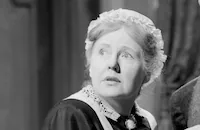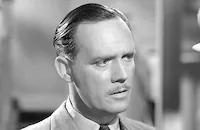The Safecracker

Brief Synopsis
Cast & Crew
Ray Milland
Colin Tapley
Ray Milland
Clive Morton
Barry Jones
Colin Gordon
Film Details
Technical Specs

Synopsis
In England a year before the start of World War II, safe-cracking expert Colley Dawson gains the admiration of his boss, Herbert Fenwright, and several notable businessmen when he demonstrates how easy it is to break into the house of a wealthy lord and open his "unbreakable" safe. Later, Colley assists Scotland Yard in opening a bank vault that has been re-set by an inside thief. At his cramped home, Colley complains to his mother that although his rare expertise consistently brings important customers to Fenwright's, he is paid only a pittance. The next afternoon, Colley is approached by Bennett Carfield, the owner of an arts shop and one of the men at the safe-breaking demonstration. Recognizing Colley's appreciation of art and his economic frustrations, he asks Colley if he would use his skills to steal rare art objects for Carfield's affluent buyers, who are unconcerned over how prized pieces are obtained. Colley negotiates for half of the proceeds, then agrees. Carfield warns Colley not to spend the money in an obvious way or they will be caught immediately. Soon after teaming with Carfield, Colley takes the assumed name of Simon Ledburn, under which he purchases a Rolls Royce and rents a fashionable apartment for weekend retreats. Over the next several months, Colley, using information provided by Carfield, successfully breaks into numerous locales and spends his lavish proceeds as "Simon." Alarmed by the rising number of thefts occurring in wealthy homes, Scotland Yard begins investigating and narrows the suspects down to a handful of men in Britain capable of opening safes by listening to the tumbler, which includes Colley. When Colley realizes that his movements are being tracked by Scotland Yard, he reports to Carfield who wants to bring an immediate halt to their activities. Colley demands they do one last job to discredit the police and provide a final financial windfall. Carfield reluctantly agrees and a few days later, supplies Colley with information on an estate he has staked out. Unaware that the police have connected Colley with "Simon's" car, Colley proceeds with the job. Believing that he has evaded his constant police "tail," Colley then triumphantly picks Carfield up in his Rolls Royce to hand over the merchandise. When the police move in, Colley insists on making a run for it, terrifying Carfield. Determined not to be caught, Carfield throws himself from Colley's car and is accidentally run over and killed by the police. Mortified, Colley pulls over and is promptly arrested. Two years later, with World War II at its height, British Military Intelligence receives vital information that a list of all German espionage agents is housed in a Belgian chateau serving as local German army headquarters. Maj. Adbury is assigned to retrieve the list, but rejects the suggestion that using a convict to break into the German safe would expedite the mission. When Adbury learns that only three men in Britain can open the German safe, he interviews a paroled ex-convict, who turns down the job. Adbury then interviews Colley, who is serving a ten-year sentence for his crimes. Cynical and indifferent to the progress of the war, Colley refuses to help when Adbury is unable to guarantee that his participation would secure his release. Although uneasy about using Colley, Adbury learns that the other safe expert convict is gravely ill and he has no other choice but to obtain assurance that Colley will be paroled after the mission. Colley is then transferred to a military training camp where he meets the members of the mission who will transport him safely to the chateau. To his dismay, Colley is ordered to undergo a week of rigorous physical training, including parachuting lessons. None of the team members is told Colley's true identity, only that he is the crucial link in the operation. Upon parachuting into Belgium, Colley is separated from the others when his parachute is caught in a tree. The Belgian underground escorts Adbury and the men to a safe farmhouse for the night while others search for Colley. Iréne, a member of the resistance, finds Colley and, evading a German patrol, brings him to the barn where the others are hiding. Adbury is distressed when Colley admits that he was unable to bury his chute successfully. Later that night, the patrol discovers Colley's parachute and investigate all the local residences. Iréne is forced to endure the humiliating attentions of a German soldier in order to divert him from exploring the barn too closely. Witnessing the incident, Colley is puzzled by Iréne's actions and at dawn, instead of preparing to depart, questions her willingness to sacrifice herself. Colley admits he has no motive for participating in the mission other than winning his freedom. Adbury, Colley and the men then make their way to the chateau where their careful plan centers on leaving no evidence of their break-in, so the Germans will not know the list of agents has been compromised. After successfully entering the chateau, Colley is diverted by the art contents of a locked glass cabinet, until directed to the safe by Adbury. The safe has two dials and as Colley begins working on them, blaring German music startles the men. Colley struggles to hear the tumblers and eventually opens the safe where the list is found and photographed, then he resets the safe dials. As the men creep away, Colley cannot resist returning to the glass cabinet which he unlocks and then removes a rare, valuable art piece. Relocking the cabinet, Colley pauses to admire the object and is spotted by a German officer who shoots him. While the alerted Germans rush to check the safe, Adbury returns to Colley, who dies. When the Germans find the safe apparently untouched, they are mystified by the presence of the lone burglar. Several months later, Mrs. Dawson receives Colley's official pardon and a commendation for his heroic action.

Director

Ray Milland
Cast
Colin Tapley

Ray Milland
Clive Morton
Barry Jones
Colin Gordon

Barbara Everest
David Horne
Jackie Collins
Charles Lloyd Pack

Cyril Raymond
Ferdy Mayne
John Welsh
Arnold Bell
Gerald Case
Melissa Stribling
Anthony Nicholls
Pamela Stirling
John Robinson

Basil Dignam
Ernest Clark
Sam Kydd
Hilda Fenemore
Percy Herbert
Richard Shaw
Ian Macnaughton

Victor Maddern
Bernard Fox
Bernard Foreman
Eddie Eddon
David Lodge
Barry Keegan
Henry Vidon
Jeanette Sterke
Richard Marner
Wolf Frees
Carl Conway
Ernst Walder
Crew
Angela Allen
Richard Rodney Bennett
Dave Boulton
Bob Carrick
Lt. Col. Rhys Davies
Gerald Gibbs
Ernest Holding
Joan Johnstone
Bill Lodge
Muir Mathieson
David Middlemas
Paul Monash
Captain J. L. H. Owen
David E. Rose
David E. Rose
Elliot Scott
Jeff Seaholme
John R. Sloan
J. B. Smith
Bruce Thomas
Gerry Turner
Ernest Walter
A. W. Watkins

Film Details
Technical Specs

Articles
The Safecracker
The first half of the film charts the rise and fall of his brilliant career, robbing treasures from the London clients of an antiques dealer (Barry Jones) with a black market sideline and living it up in a double life. During the week he lives in a dowdy apartment with his aging mum but come the weekend he's a high-living society blade spending his ill-gotten gains between jobs. His criminal career is ended long before the film is and the second half picks up in the midst of World War II. A special assignment behind enemy lines calls for the very expert skills wielded by Colley, the best safecracker behind bars, and the mission commander (Ernest Clark) reluctantly drafts Colley into his unit.
British born Ray Milland had a thriving Hollywood career through the forties and fifties, thanks to his mix of class, dignity and everyman geniality; he starred in well over a hundred films in his career, but he also had a second career as a director. This low-budget British production, made for MGM in 1958, was the third of his five directorial features. One wonders if Milland agreed to direct in exchange for taking the lead, for he is somewhat miscast in the role of a restless, ambitious guy with a special gift and a yearning for the better things in life (he spends his Sundays staring at the treasures of the British Museum). As played by Milland, Colley becomes a fifty-something angry young man still living at home and toiling unhappily as a hired hand for the better part of his life.
As a director, Milland doesn't bring much style or tension to the film. The Safecracker skips over most of the robberies and the script is short on the kind of physical detail that defines most heist films. Colley's technique comes down to brazen audacity; in one instance, he robs a bedroom safe while the owner snores away in his bed a few feet away. Milland's smiling confidence carries the scenes and defines the character of Colley: it's not just the money that turns him into a safecracker, it's the thrill of the job. When Scotland Yard starts sniffing around his double life, Colley turns it into a challenge to pull off a job right under their noses. That kind of audacity is just what this mission calls for. While he's not much of a soldier, even after a crash course in basic training (played for light humor as Milland quips his way through obstacle courses and paratrooper jumps), he's in his element when it comes to breaking into a villa in occupied Belgium commandeered by the Nazi military. And as the men slowly warm to and eventually accept this sardonic new member of the unit, he returns the favor by giving them tips on breaking and entering like a pro.
Barry Jones, who plays the crooked antique dealer that becomes Colley's partner in crime, was a busy character actor specializing in authority figures and powerful men (including the Emperor Claudius in the American costume drama Demetrius and the Gladiator, 1954); he brings dry humor, confidence and a sly arrogance to his role here. Ernest Clark was no stranger to playing military men when he took the role of the mission commander but he found fame years later playing the crusty Sir Geoffrey Loftus in the long-running Doctor in the House TV series and its subsequent incarnations. Character actor Bernard Fox (who made a career playing offbeat Brits on American TV, notably the eccentric Dr. Bombay on Bewitched) has a few lines as one of the soldiers in the special unit and Thomson, the talkative soldier, is played by Ian MacNaughton, who later made his fame directing every episode of the cult comedy series Monty Python's Flying Circus.
Producer: David E. Rose, John R. Sloan (producer)
Director: Ray Milland
Screenplay: Paul Monash (writer); Lt. Colonel Rhys Davies, Bruce Thomas (story)
Cinematography: Gerald Gibbs
Art Direction: Elliot Scott
Music: Richard Rodney Bennett
Film Editing: Ernest Walter
Cast: Ray Milland (Colley Dawson), Barry Jones (Bennett Carfield), Jeanette Sterke (Irene), Victor Maddern (Morris), Ernest Clark (Major Adbury), Cyril Raymond (Inspector Frankham), Melissa Stribling (Angela), Percy Herbert (Sergeant Harper), Barbara Everest (Mrs. Dawson), Anthony Nicholls (General Prior).
BW-96m.
by Sean Axmaker

The Safecracker
Quotes
Trivia
Notes
The working title of the film was The Willie Gordon Story.

Miscellaneous Notes
Released in United States Winter January 1958
Released in United States Winter January 1958














